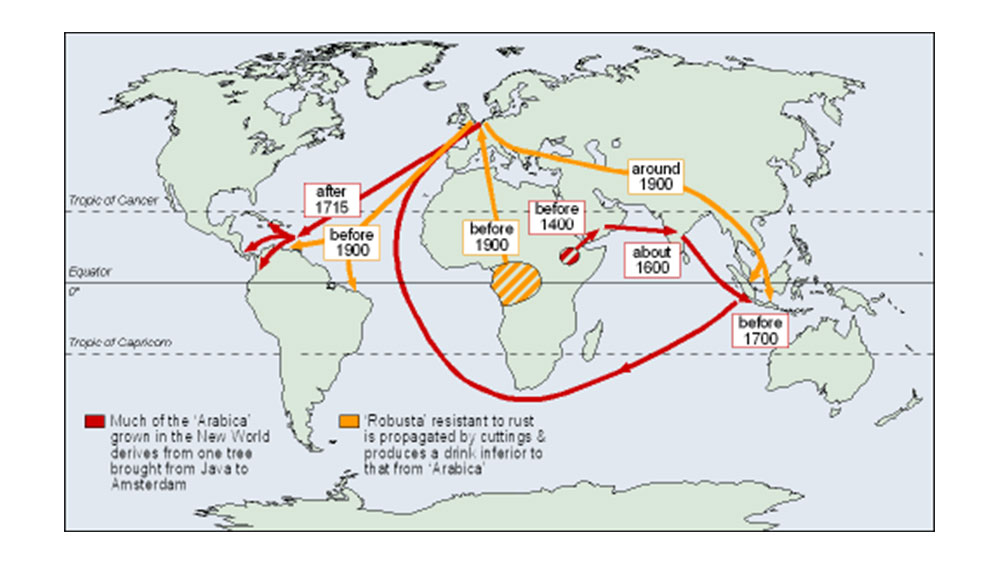A Coffee Legend or Two
The history of coffee is tied inextricably tied to the history of the world. Coffee can be grown all over the world, but between the Tropic of Cancer and the Tropic of Capricorn is where it thrives. This region is referred to as the coffee belt. Although the exact origin of coffee is unknown, the earliest records point to coffee’s birthplace as East Africa, more specifically, Ethiopia. Soon after that, coffee moved to the Arabian Peninsula.
Legend claims that an eighth-century herder (sometimes referred to as Kaldi) noticed his goats jumping around energetically after eating a mysterious plant. When he tried the fruit, the herder noticed it kept him awake at night! The herder took the fruit to a local monastery, where beans were boiled in water. And just like that (as the legend goes) the first cup of coffee was born!
An Early History of Coffee
Coffee “beans” are actually not beans at all, but small berries. Early in their history, they were simply eaten for energy. Sufis used coffee for spiritual purposes, in order to stay alert in their studies. They soon found it aided with concentration, and it gained popularity in that region’s religious world during the reign of the Ottoman Empire.
By 1414, coffee had spread to Mecca and Medina, the two most prominent religious cities at that time. Coffee “houses” started popping up all around larger cities as a place for religious scholars to gather in community and share ideas. Since religious leaders were not permitted to drink alcohol, this was their alternative for a social meeting place.
“Satanic” Coffee?
Controversy soon arose as groups of conservatives within the Islamic rule banned the consumption of coffee due to its energizing effect, but this was short-lived. By the 16th century, coffee had spread all over the Middle East and had also made its way into Europe. As the global awareness of coffee spread, it was also met with some level of opposition in other areas.
The Ethiopian Orthodox Church also banned coffee for a time, as it was under scrutiny for originally being a Muslim drink. They considered coffee’s stimulative effect to be similar in nature to alcohol or tobacco, which was taboo in their belief system. Italian clergy also tried to ban coffee, considering it to be “satanic”. Luckily for coffee drinkers in that region, Pope Clement VIII disallowed the ban due to the fact that he loved coffee so much!
Despite various controversies about coffee throughout the 16th and 17th centuries, coffee became a crucial part of the trade economy in the areas surrounding the Red Sea, for traders passing by or Muslims making their way to holy cities. Of course, this was just the beginning of coffee’s global influence that remains today!
Going Global
Coffee consumption slowly transitioned from sites of religious education to more secular sites of education. The first known consumption of coffee in Europe was in Venice, which had extensive trade connections with North Africa and the East. The first Austrian coffee houses emerged after the Battle of Vienna in 1683, where supplies left over from the defeated Turks were scavenged and used to create their own special style of coffee.
Hubs like these were diverse and multicultural, with their creation, there arose a new take on coffee houses. This idea spread all over Europe as coffee houses became common for intellectuals, for social meetups as well as discussing news and current events. At that time, coffee was actually cheaper than clean drinking water, and the alternative was beer. This drew a clear line between those who dreamed of new inventions, new worlds, and new philosophies, and those who would rather spend their days in a tavern.
Later, coffee and the Enlightenment worked hand in hand, as new ideas and intellectual discussions could be bought with a cup of coffee. Coffee houses were referred to as a “penny university”, as they allowed anyone to participate in intellectual discussion. Thus, they bridged the gap in socioeconomic status, as the price for coffee was cheap, enabling both the rich and poor to discuss wide varieties of topics.
Colonialist Coffee
Eventually, the demand for coffee increased due to the fact that it was a highly sought after cash crop and was taken to colonized nations in order to capitalize on this important trade resource. Coffee played a large role in colonization as it was a highly sought-after resource at this time. The Dutch were the first to successfully grow and cultivate the crop, in modern-day Indonesia, marking the first successful spread to the Western world. In addition, a seedling from a coffee plant in the royal French garden was brought to Martinique by a royal officer, which is said to be the mother plant of all coffee in the Caribbean and the New World.
A key factor to the rise of popularity in the Americas was the Boston Tea Party. After protesters dumped boatloads of tea to protest taxation without representation on said tea, drinking tea in America became unpatriotic, leading to the rise of coffee drinking as a substitute.
Regardless, European colonies and American colonies alike all put much of their plantation efforts into growing coffee. Overall, coffee In the Americas, Caribbean territories, and parts of Africa, colonizers, travelers, and missionaries continued to spread the coffee plant until it was a precious commodity throughout the world. Coffee economies continued to flourish and sustain many nations, and reached every corner of the globe as a necessity.
Coffee Around the World
Today, it is the second most sought-after commodity, only after crude oil. As many people all over the world would agree, the discovery and spread of coffee is a key part of culture and society, throughout history and today. Brazil is currently the country that produces the highest yield of coffee, due to the region which holds the ideal climate for growing coffee.
The average American drinks around 11 pounds of coffee a year! And while coffee should be drunk in moderation, studies show that drinking 3-4 cups a day can reduce the risk of cardiovascular disease, Parkinsons, and can even increase your lifespan.
Since coffee was first brewed, we have been able to figure out its flavor and how to brew it in different styles for different tastes. The type of soil it is grown in or the nutrients around it can alter the taste of the finished product. Even the amount of humidity or the climate can have an affect on the flavor profile of coffee! Culturally, traditional coffee is different depending on the country or region. In the United States, the popular way to drink coffee is with sugar and cream, but that is not necessarily the norm for the rest of the world.
In Portugal, they drink a mix of lemon juice and iced coffee, called Mazagran. In Mexico, a popular version of coffee is brewed mixed with cinnamon sticks. Without any additives, different coffees can also be grown with a variety of flavors. In addition, how coffee beans are roasted also determines their flavor. A lesser-roasted coffee will have a more bitter taste, and acidic flavor. But the more a coffee is roasted, the less caffeine it retains! A dark roast coffee will have a bolder, smokier, taste, but have less caffeine than a light roast.
It is safe to say while coffee may not be for everyone, that there are plenty of options to learn about and try out. Stay tuned at Raj’s Coffee Co. to learn more about different flavors, ways to brew, and everything in between!

